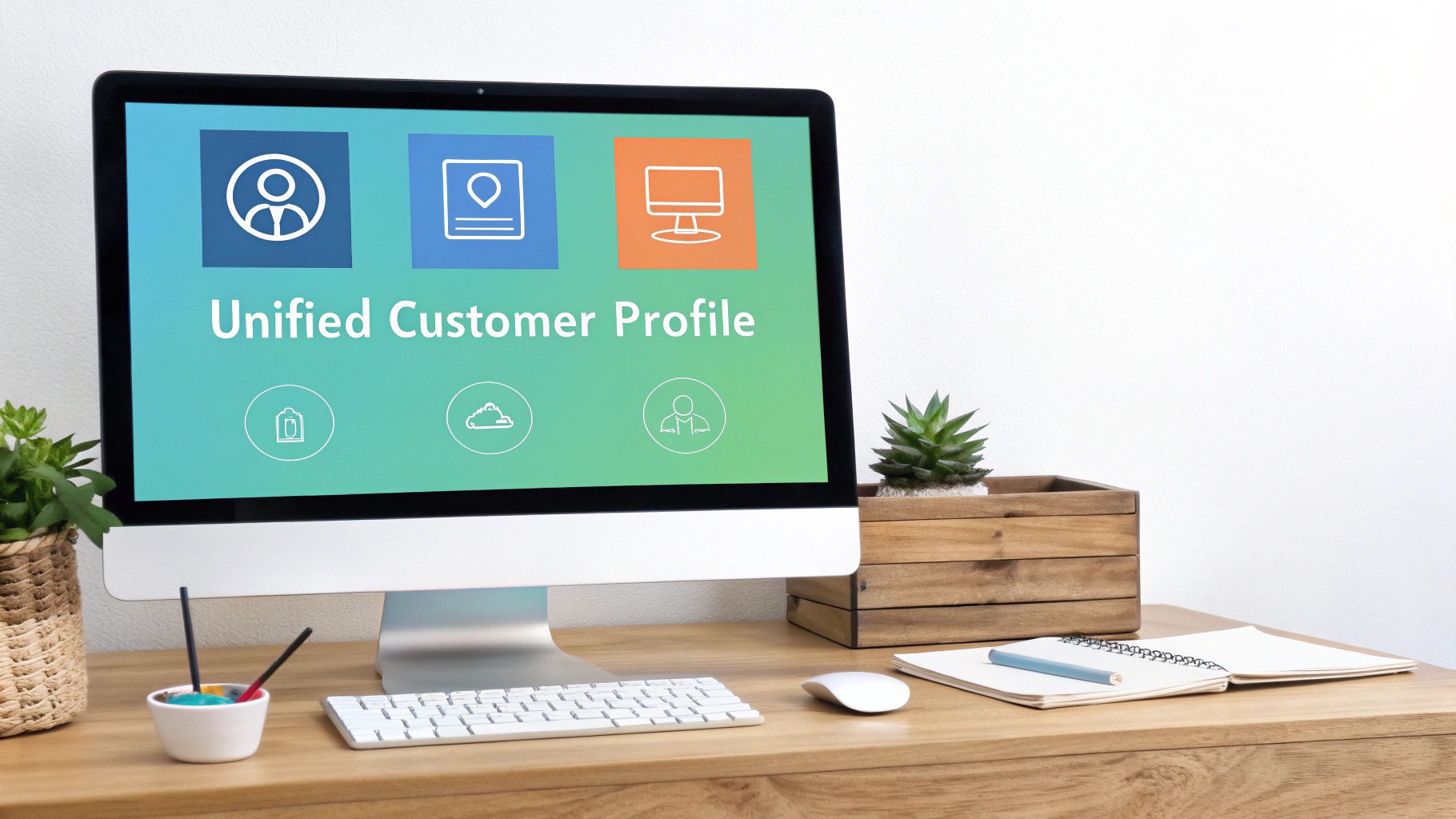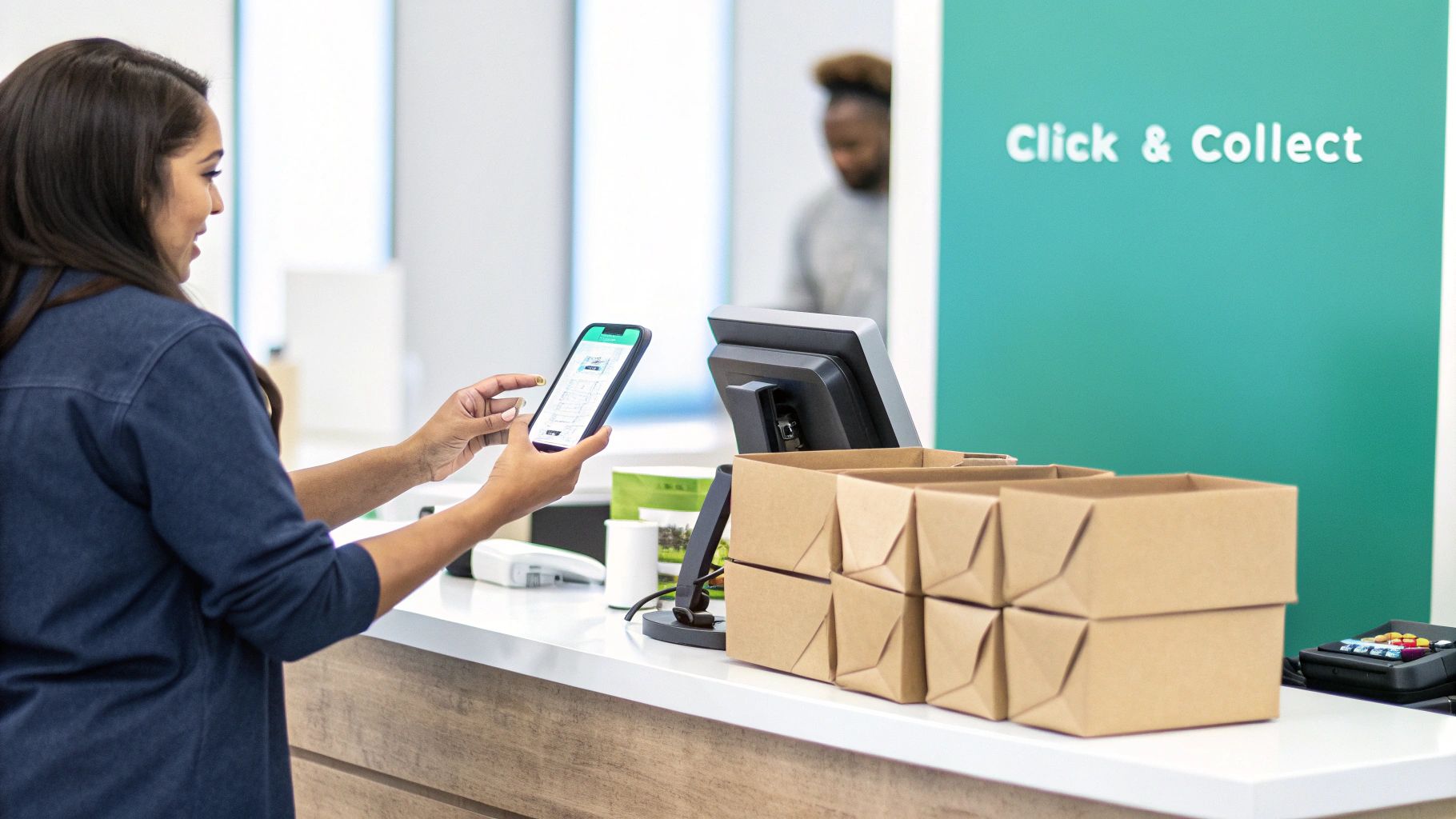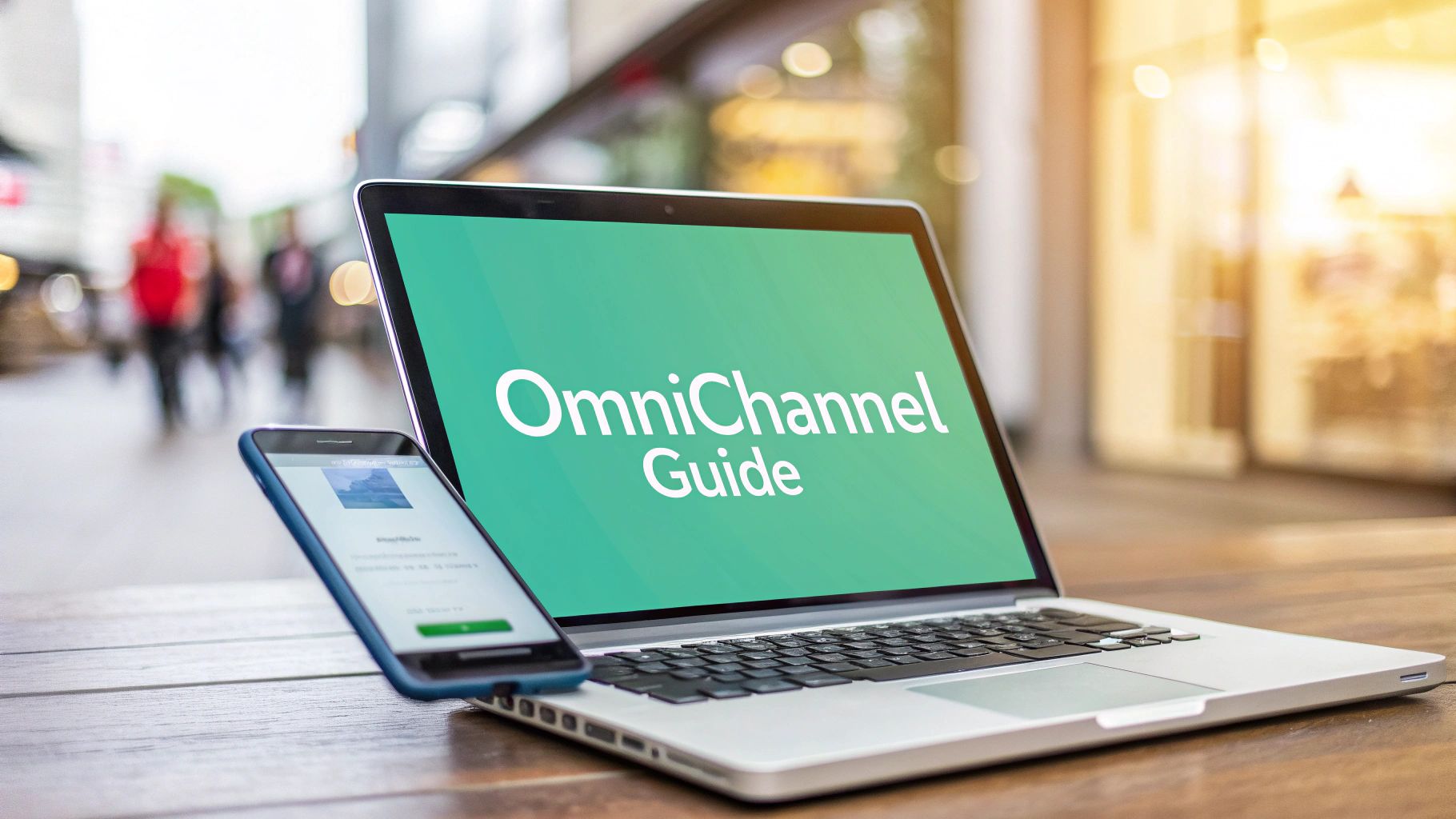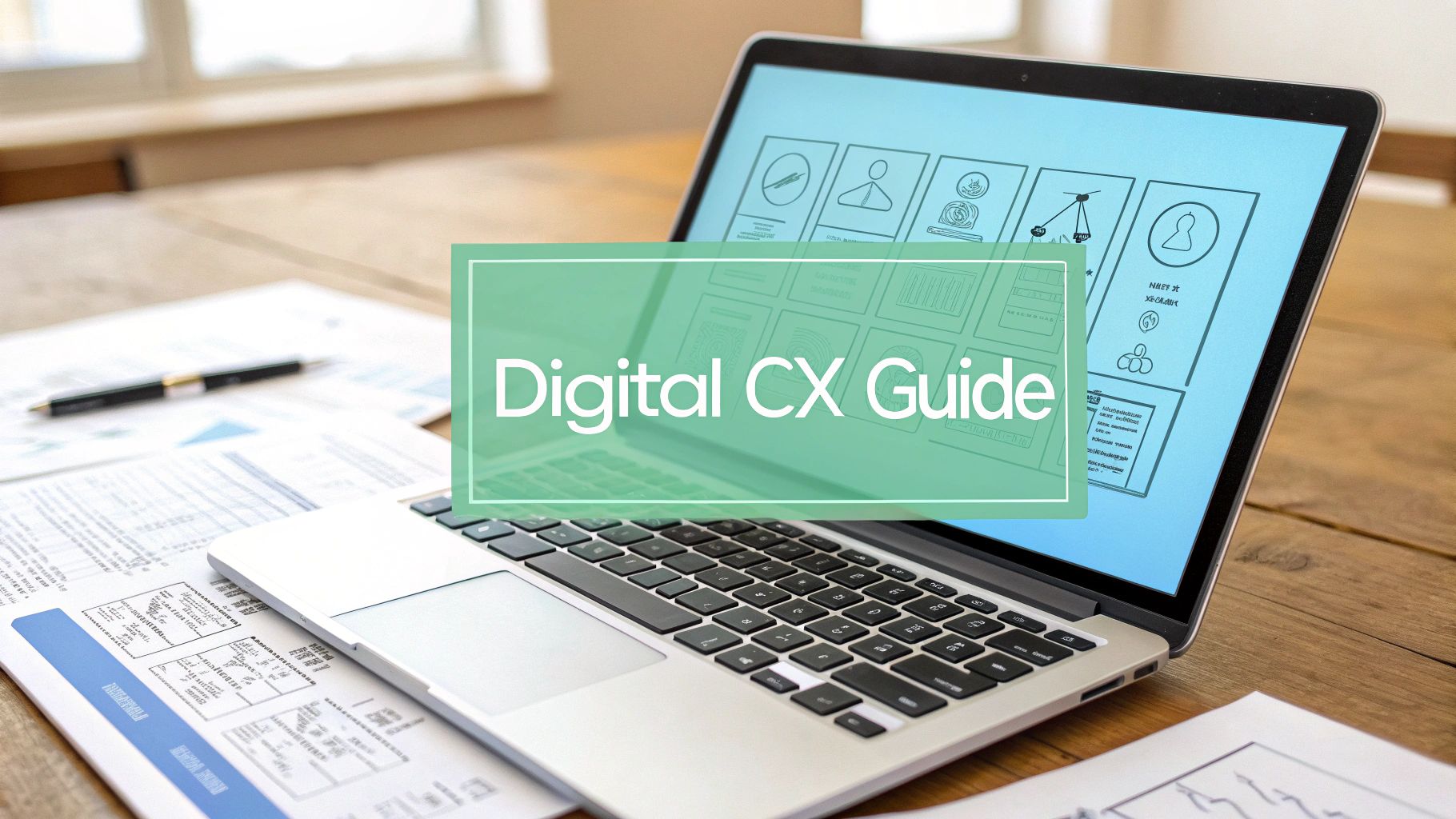Picture this: your brand is having a single, continuous conversation with a customer, no matter where they are or how they choose to connect. That, in a nutshell, is the heart of an e commerce omnichannel strategy. It’s all about weaving every customer touchpoint—online, on mobile, and in a physical store—into one seamless experience.
Moving Beyond Multichannel to True Omnichannel Commerce
Many businesses operate a multichannel model, which is a bit like having separate, disconnected storefronts. Sure, you have a website, a mobile app, and a physical store, but they don't really talk to each other. Information is siloed, and the customer journey feels disjointed and clunky.
Think about it. A customer sees a product they love on your Instagram, but when they go to the store, it's not there. Worse, they can't even check the local inventory from your website. This kind of friction doesn't just annoy customers; it pushes them away.
An e-commerce omnichannel strategy fixes this by bringing all those channels together. It’s the difference between shouting from different rooms and having one coherent, intelligent dialogue with your customer. This unified approach isn't just a "nice-to-have" anymore—it's what modern customers expect.

Why the Shift Is Critical
The demand for these kinds of integrated shopping journeys is a huge market driver. A truly unified approach means a customer can:
- Browse for an item on their phone during their morning commute.
- Add that item to their cart on a laptop later in the day.
- Swing by the physical store to pick it up on their way home, all without a single hitch.
That kind of seamless journey is what builds real, lasting brand loyalty. Understanding the nuts and bolts of omnichichannel messaging for customer engagement is the first step for businesses aiming to build these powerful connections. The industry's rapid growth in this area signals a clear shift: businesses must adapt to meet customers where they are with the convenience and continuity they crave.
Setting the Stage for Advanced Platforms
Pulling this off requires a powerful tech foundation. This is where platforms like Sitecore come in, as they're built from the ground up to manage the complexities of an omnichannel strategy. They give you the tools to unify customer data, personalize every interaction, and deliver consistent content across every single channel.
The goal of an omnichannel strategy is to make the boundaries between channels invisible to the customer, creating a single, fluid, and continuous brand experience.
By moving beyond a simple multichannel setup, you create a system where every interaction informs the next, making the customer feel understood and valued. This is what prepares your business for advanced digital experience platforms that can bring this vision to life at scale. You can learn more by exploring our detailed guide on the omnichannel customer experience. This shift from a channel-first to a customer-first mindset is what defines a winning modern commerce strategy.
The Three Pillars of an Omnichannel Strategy

A true e commerce omnichannel strategy isn't just about bolting on new technology. It's a fundamental shift in how you see your business, built on three core pillars. When these pillars are strong, they create a seamless journey that makes customers feel understood and valued, no matter where they are.
Get them right, and you’ll build lasting loyalty. But if one is weak, the entire structure will fail to deliver that truly connected experience people now expect.
The first, and arguably most important, pillar is the unified customer profile. This is your single source of truth for every single person who interacts with your brand. Forget siloed spreadsheets and disconnected data points; this is a living history of their behaviors, preferences, and conversations across all channels.
This central profile goes far beyond basic demographics. It tracks every click on your website, every item added to a cart in your app, and every purchase made in-store, painting a complete picture of their journey.
The Power of a Unified Customer View
Building this level of detail requires a powerful Customer Data Platform (CDP). A platform like Sitecore CDP is engineered for exactly this. It ingests data from all your disparate systems—your e-commerce site, mobile app, CRM, point-of-sale terminals, and social media—and stitches it all together into one coherent profile.
The result is a genuine 360-degree view of each customer. You can finally see their journey in its entirety. For example, you can see that a customer first saw a product in a targeted email, researched it on their laptop, then used the mobile app to find the nearest store with that item in stock.
A unified customer profile transforms anonymous data points into a coherent customer story, forming the bedrock of genuine personalization and effective e commerce omnichannel execution.
This rich, contextual data becomes the fuel for every other part of your strategy, from hyper-relevant marketing campaigns to smarter customer service interactions.
Ensuring a Consistent Brand Experience
The second pillar is a consistent brand experience at every single touchpoint. Your brand's personality—its voice, visual style, and core messages—needs to feel the same whether a customer is browsing your website, scrolling through their Instagram feed, or walking into one of your stores. Inconsistency breeds confusion and erodes trust.
This is where a modern content management system becomes indispensable. Sitecore’s content capabilities, especially within a composable architecture, empower marketing teams to create and manage all content from a central hub. This guarantees that promotional banners, product descriptions, and brand stories look and sound the same everywhere.
Think about a major holiday sale. With a unified content strategy, the same visuals, taglines, and offers are pushed out simultaneously to:
- The homepage of your website.
- The main screen of your mobile application.
- Digital signage inside your retail locations.
- Your email marketing campaigns.
This consistency makes the brand feel polished and reliable, reinforcing who you are at every turn.
Integrating Inventory and Operations
The final pillar is integrated inventory and operations. This is the behind-the-scenes engine that makes the whole seamless experience possible. It’s all about creating a real-time, two-way data flow between your commerce platform and your backend systems, like your Enterprise Resource Planning (ERP) and inventory management software.
This integration is what powers some of the most popular omnichannel features. When a customer checks for product availability online, your website is querying the exact same inventory data that the in-store POS system uses. This simple act of accuracy prevents massive customer frustration and saves countless sales.
The technical magic behind this pillar enables the features customers love:
- Buy Online, Pick Up In-Store (BOPIS): A customer can confidently buy an item online, knowing it’s actually waiting for them at their local store.
- Ship from Store: You can fulfill online orders from the nearest retail shop to slash shipping times and costs.
- Endless Aisle: An in-store associate can order an out-of-stock item for a customer on the spot and have it shipped directly to their home.
These three pillars—a unified customer profile, a consistent brand experience, and integrated operations—work in harmony. Together, they create a powerful e commerce omnichannel strategy that doesn’t just meet modern expectations but exceeds them.
Building Your Omnichannel Engine with Sitecore DXP
An effective e-commerce omnichannel strategy needs more than just a good idea; it needs a powerful, flexible engine to make it all happen. This is where a composable Digital Experience Platform (DXP) like Sitecore really shines. Forget rigid, all-in-one systems. A composable architecture is like building with high-performance, specialized LEGO bricks that are designed to click together perfectly.
This approach gives you the agility modern commerce demands. It lets you hand-pick the best tools for each job—whether it's content, commerce, search, or data—and then connect them through APIs. The result is a custom-built engine tuned precisely to your business, not a one-size-fits-all box that forces you to compromise.
The MACH Architecture Advantage
At the heart of this modern approach is MACH architecture. The acronym stands for a set of principles that future-proof your tech stack and let you innovate quickly. Think of it as the blueprint for a resilient and adaptable omnichannel system.
- Microservices: Instead of one giant application, your platform is built from small, independent services that each handle a specific job, like checkout or search. This means you can update or swap out one service without taking the whole system down.
- API-first: Every component talks to the others through APIs. This creates a universal language that makes it easy to plug in new tools, channels, and customer touchpoints as you grow.
- Cloud-native: The entire platform is built for the cloud from the ground up. This gives you the power to scale for massive traffic spikes, ensures your system is always online, and takes the headache of managing physical servers off your plate.
- Headless: The front-end presentation layer (the "head," like your website or app) is completely separate from the back-end commerce engine. This freedom allows you to design unique customer experiences for any device without being boxed in by back-end limitations.
A composable DXP built on MACH principles gives you the freedom to evolve. It’s not about predicting the future; it's about building a system that can adapt to whatever comes next, whether that’s a new social commerce channel or the Internet of Things.
This architectural foundation is exactly what makes Sitecore’s product portfolio the ideal core for a world-class omnichannel engine.
Core Components of the Sitecore Omnichannel Engine
Sitecore's composable DXP is a suite of powerful, specialized products that work together to create one seamless customer journey. Each one plays a distinct, critical role in your e-commerce omnichannel strategy. Think of them as the key parts of your commerce engine, each one expertly engineered for its specific task.
1. Sitecore XM Cloud: The Content Hub
XM Cloud is a cloud-native, headless CMS. It’s the central command for all your marketing content, from website banners to product descriptions. Because it’s headless, you can create content once and push it out via API to any channel imaginable—your website, mobile app, in-store displays, or even a smartwatch. This keeps your brand consistent everywhere and lets your marketing team make quick updates without calling a developer for every little change.
2. Sitecore OrderCloud: The Commerce Foundation
OrderCloud is a seriously powerful, API-first headless commerce platform. It handles all the heavy lifting for your e-commerce operations, including product catalogs, complex pricing, promotions, and order management. Its "headless" nature means it can power any front-end experience you can dream up, making it the perfect foundation for tricky omnichannel scenarios like B2B, B2C, and multi-vendor marketplace models.
3. Sitecore Discover: The AI-Powered Search Brain
A basic search bar just doesn't cut it anymore. Sitecore Discover uses AI to deliver hyper-relevant, personalized product searches, recommendations, and merchandising. It learns from every shopper's behavior in real-time to figure out what they want, often before they even know it themselves. The result? Higher conversion rates and bigger average order values.
4. Sitecore CDP: The Unified Customer Data Core
This is the heart of your data strategy. Sitecore's Customer Data Platform (CDP) pulls in, cleans, and unifies customer data from every single touchpoint. It’s what builds that all-important 360-degree view of your customer and feeds real-time insights into your other systems. This unified data is the fuel for true one-to-one personalization across your entire ecosystem, making every interaction feel relevant. To see it all in action, you can learn more about building powerful digital experiences on the Sitecore platform and see how these components fit together.
Delivering Hyper-Personalization Across Every Channel
Having a powerful omnichannel engine is just the start. The real magic of an e commerce omnichannel strategy kicks in when you use that unified data to make every single customer feel seen and understood. This is hyper-personalization—the human touch that turns great technology into an unforgettable experience.
This is exactly where the combination of Sitecore CDP and Sitecore Discover becomes so critical. Together, they turn raw data into real-time, one-to-one conversations on a massive scale. It’s about getting past simply showing "relevant" products and starting to anticipate what a customer might need next.
Let's walk through an example. A customer buys a pair of hiking boots in your physical store. The second that transaction is logged, Sitecore CDP updates their profile. When they browse your website later that day, Sitecore Discover instantly recognizes them and surfaces personalized recommendations for waterproof socks, backpacks, and other hiking gear. This isn't just a generic "people also bought" suggestion; it's a direct, intelligent response to their recent offline behavior.
Fueling Real-Time Decisioning
This incredible level of responsiveness is driven by real-time decisioning. As Sitecore CDP gathers data from every interaction—a page view, an abandoned cart, an in-store purchase—it feeds this information straight to a decisioning engine. This engine uses predictive analytics to score customer intent and figure out the next best action, all in a matter of milliseconds.
This allows you to deliver the right message, at the right moment, through the right channel. Imagine a high-value customer who was looking at winter jackets on your app walks past your store. You could trigger a push notification with a special in-store offer for that exact product category. This is the ultimate goal: making every single interaction contextually aware and deeply personal. You can dig deeper into this with our guide on the five simple steps toward better personalization with Sitecore Personalize.
This concept map shows how a modern omnichannel engine works, with a central hub that manages data, content, and commerce as interconnected parts.

The visual makes it clear: a winning strategy needs all three of these elements working in perfect sync, all fueled by unified customer data.
The Business Impact of True Personalization
When customers feel like you get them, they stick around and become more valuable to your business over time. Companies with strong omnichannel engagement strategies have shown significantly higher customer retention rates compared to those with weaker approaches.
Even better, shoppers who interact with a brand across multiple channels are often more valuable over their lifetime than those who only use a single channel.
Hyper-personalization is the ultimate payoff for your omnichannel investment. It proves to the customer that you've been listening across all channels and are ready to deliver an experience tailored just for them.
Ultimately, combining a unified data core like Sitecore CDP with an intelligent recommendation engine like Sitecore Discover lets you create these high-impact moments again and again. It closes the loop between collecting data and delivering a great experience, ensuring your e commerce omnichannel strategy does more than just connect channels—it builds lasting relationships.
Integrating SharePoint to Power Your Internal Operations
A world-class customer experience is impossible without world-class internal operations. While a platform like Sitecore handles the customer-facing side of your e commerce omnichannel strategy, SharePoint is the central nervous system for your backend processes. It ensures every team member has the tools and information they need to execute flawlessly, bridging the critical gap between your customer-facing tech and the people who make it all work.
Think of SharePoint as your internal command center. It’s a single, secure hub for everything from employee training materials and marketing campaign assets to complex collaborative workflows. When your internal teams are aligned and empowered, the customer experience becomes naturally more consistent and efficient.
Creating a Single Source of Truth for Your Teams
One of the biggest operational hurdles in any omnichannel setup is inconsistency. It's easy for different teams to end up using outdated promotional graphics, incorrect product information, or conflicting procedural documents. The result? A fractured and confusing customer experience. SharePoint tackles this problem head-on by creating a single source of truth.
When a new promotion is ready to launch, for instance, all approved assets and guidelines can live in a central SharePoint site. This means your teams across retail, customer service, and digital marketing are all working from the same playbook.
- Retail staff can access training videos on new in-store displays right from the floor.
- Customer service agents can pull up the latest return policy updates in seconds.
- Digital marketers can download approved creative assets for social media campaigns, knowing they're the right ones.
This synchronized approach eliminates guesswork and gets the correct information to your employees right when they need it. For businesses looking to build this kind of internal alignment, exploring specialized SharePoint solutions is a foundational step toward operational excellence. This cohesion is what empowers every employee to deliver on the omnichannel promise.
Seamless internal operations are the invisible foundation of a remarkable customer journey. When your teams are connected and informed, that efficiency is felt at every customer touchpoint.
Powering Collaboration Through Integration
Beyond just storing assets, SharePoint's real power comes alive through its integration capabilities, which often rely on a solid API strategy. Understanding how APIs in ecommerce allow different systems to talk to each other is key. For example, you can connect SharePoint with your Sitecore DXP to automate workflows between your customer-facing platforms and your internal teams.
Imagine a customer service ticket logged through your website (powered by Sitecore) that automatically creates a task in a SharePoint workflow. This task could then be routed to the right department, with all the relevant customer history attached, ensuring a swift and informed resolution. This level of integration turns siloed departments into a unified operational force, making your e commerce omnichannel strategy just as strong on the inside as it is on the outside.
Deploying High-Impact Omnichannel Features

A solid strategy is a great start, but it’s the tangible, high-impact features that really bring an e-commerce omnichannel experience to life. This is where your investment turns into real convenience for your customers, fostering loyalty and driving measurable results. To pull this off, you need a flexible, API-first architecture, which is exactly where a platform like Sitecore OrderCloud shines.
Let's dive into the most valuable omnichannel features and the tech that makes them tick. These aren't just trendy add-ons; they solve common customer headaches and turn potential frustrations into moments of outstanding service.
Powering BOPIS and Click & Collect
"Buy Online, Pick Up In-Store" (BOPIS), also known as "Click & Collect," is a customer favorite. It perfectly blends the convenience of online browsing with the instant gratification of brick-and-mortar retail. A customer can buy from their couch and have the product in their hands within hours, completely skipping shipping costs and delays.
But here's the catch: its success hinges entirely on real-time inventory visibility.
BOPIS fails spectacularly if a customer buys an item online only to show up and find it’s out of stock. That kind of experience doesn't just inconvenience them; it breaks trust.
Sitecore OrderCloud's API-first design is built to prevent this exact scenario. It can seamlessly connect with all your inventory systems—from the main warehouse ERP to each store's point-of-sale—to create a single, unified view of what's in stock, where. When a customer places a BOPIS order, the platform can instantly reserve that specific item at their chosen store, guaranteeing it's waiting for them.
Implementing the Endless Aisle
The "endless aisle" is another game-changer that turns a potential lost sale into a saved one. Imagine a customer in your store wants a shirt, but you don't have their size. Instead of letting them walk out empty-handed, an associate can use a tablet or kiosk to order it from another store or warehouse and ship it directly to their home.
This feature relies on the same powerful inventory integration. OrderCloud’s flexible architecture lets you set up sophisticated fulfillment rules. You can configure it to:
- Check inventory across every single location in real-time.
- Route the order to the most efficient fulfillment center.
- Process a single payment that combines items they're taking home today and items being shipped.
The Rise of In-Store Stock Visibility
Today's shoppers expect to know what's in stock before they even leave the house. Being able to check local store availability online is no longer a nice-to-have; it's a basic expectation that removes all the guesswork from a shopping trip. In fact, adoption of this feature is widespread among top retailers, indicating a clear market standard.
For a deeper look at industry trends, analysis from sources like e-commerce feature adoption shows just how critical these capabilities have become.
Features like BOPIS, the endless aisle, and real-time stock checks do more than just add convenience. They drive foot traffic to your stores, increase average order value through in-store upselling, and build deep customer loyalty by showing you respect their time.
Frequently Asked Questions About Omnichannel Sitecore Implementation
Diving into an e commerce omnichannel strategy with Sitecore brings up a lot of questions. Getting straight answers is key to planning a successful rollout and making sure your tech investments line up with your actual business goals. Here are a few of the most common questions we hear from businesses.
The best place to start is always with a deep dive into your data and a solid strategy session. Before you even think about technology, you need to know where your customer data lives, what’s missing, and what you’re trying to achieve. The first real step is figuring out how to build a unified customer profile—a task that a tool like Sitecore CDP was built for.
How Does a Composable DXP Differ from a Monolithic Platform?
This is one of the most important questions for any business building a modern tech stack. A monolithic platform is an all-in-one system, but that single package often becomes rigid and slow to adapt when new market demands pop up. A composable DXP, like what Sitecore offers, is all about flexibility.
With a composable approach, you can pick the best tools for each job—like OrderCloud for commerce and XM Cloud for content—and connect them with APIs.
This architectural freedom is key for a successful e commerce omnichannel strategy. It lets you add new channels or adapt to changing customer habits without tearing down and rebuilding your entire system.
That agility is what keeps your platform in sync with your business and your customers' expectations.
Can Sitecore Integrate with My Existing ERP and Inventory Systems?
Absolutely. In fact, integration is one of the biggest strengths of Sitecore’s product family. The API-first design, especially in products like Sitecore OrderCloud, is built specifically for clean and simple integration with the business-critical systems you already rely on.
This is what makes real-time data sync possible, which is essential for things like:
- Accurate inventory levels showing up across all your channels.
- Seamless order management, from the moment a customer clicks "buy" to the final delivery.
- Consistent customer information between your e-commerce platform and your CRM.
This kind of deep integration isn't just a tech feature; it's the operational backbone of any great omnichannel experience. It ensures that the promises you make on the front-end are actually delivered on the back-end. This is where Sitecore, along with supporting platforms like SharePoint, becomes so valuable in creating a system that just works.
At Kogifi, we specialize in building powerful digital experience platforms that drive results. If you're ready to build a world-class e commerce omnichannel strategy with Sitecore or SharePoint, our team of experts is here to help. Contact us today to start your digital journey.






































